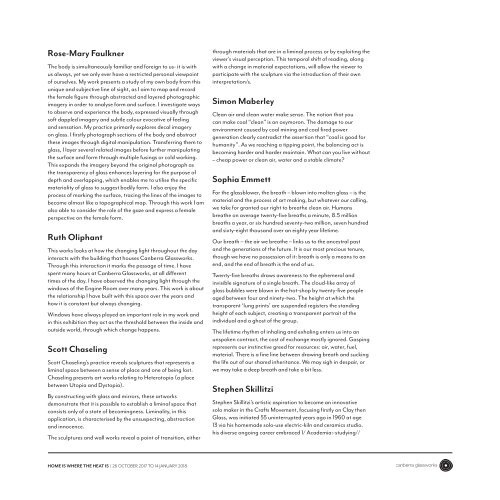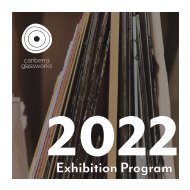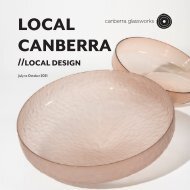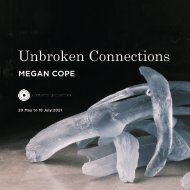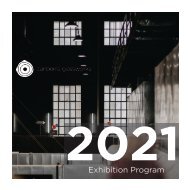Home is where the heat is
You also want an ePaper? Increase the reach of your titles
YUMPU automatically turns print PDFs into web optimized ePapers that Google loves.
Rose-Mary Faulkner<br />
The body <strong>is</strong> simultaneously familiar and foreign to us- it <strong>is</strong> with<br />
us always, yet we only ever have a restricted personal viewpoint<br />
of ourselves. My work presents a study of my own body from th<strong>is</strong><br />
unique and subjective line of sight, as I aim to map and record<br />
<strong>the</strong> female figure through abstracted and layered photographic<br />
imagery in order to analyse form and surface. I investigate ways<br />
to observe and experience <strong>the</strong> body, expressed v<strong>is</strong>ually through<br />
soft dappled imagery and subtle colour evocative of feeling<br />
and sensation. My practice primarily explores decal imagery<br />
on glass. I firstly photograph sections of <strong>the</strong> body and abstract<br />
<strong>the</strong>se images through digital manipulation. Transferring <strong>the</strong>m to<br />
glass, I layer several related images before fur<strong>the</strong>r manipulating<br />
<strong>the</strong> surface and form through multiple fusings or cold working.<br />
Th<strong>is</strong> expands <strong>the</strong> imagery beyond <strong>the</strong> original photograph as<br />
<strong>the</strong> transparency of glass enhances layering for <strong>the</strong> purpose of<br />
depth and overlapping, which enables me to util<strong>is</strong>e <strong>the</strong> specific<br />
materiality of glass to suggest bodily form. I also enjoy <strong>the</strong><br />
process of marking <strong>the</strong> surface, tracing <strong>the</strong> lines of <strong>the</strong> images to<br />
become almost like a topographical map. Through th<strong>is</strong> work I am<br />
also able to consider <strong>the</strong> role of <strong>the</strong> gaze and express a female<br />
perspective on <strong>the</strong> female form.<br />
Ruth Oliphant<br />
Th<strong>is</strong> works looks at how <strong>the</strong> changing light throughout <strong>the</strong> day<br />
interacts with <strong>the</strong> building that houses Canberra Glassworks.<br />
Through th<strong>is</strong> interaction it marks <strong>the</strong> passage of time. I have<br />
spent many hours at Canberra Glassworks, at all different<br />
times of <strong>the</strong> day. I have observed <strong>the</strong> changing light through <strong>the</strong><br />
windows of <strong>the</strong> Engine Room over many years. Th<strong>is</strong> work <strong>is</strong> about<br />
<strong>the</strong> relationship I have built with th<strong>is</strong> space over <strong>the</strong> years and<br />
how it <strong>is</strong> constant but always changing.<br />
Windows have always played an important role in my work and<br />
in th<strong>is</strong> exhibition <strong>the</strong>y act as <strong>the</strong> threshold between <strong>the</strong> inside and<br />
outside world, through which change happens.<br />
Scott Chaseling<br />
Scott Chaseling’s practice reveals sculptures that represents a<br />
liminal space between a sense of place and one of being lost.<br />
Chaseling presents art works relating to Heterotopia (a place<br />
between Utopia and Dystopia).<br />
By constructing with glass and mirrors, <strong>the</strong>se artworks<br />
demonstrate that it <strong>is</strong> possible to establ<strong>is</strong>h a liminal space that<br />
cons<strong>is</strong>ts only of a state of becomingness. Liminality, in th<strong>is</strong><br />
application, <strong>is</strong> character<strong>is</strong>ed by <strong>the</strong> unsuspecting, abstraction<br />
and innocence.<br />
The sculptures and wall works reveal a point of transition, ei<strong>the</strong>r<br />
through materials that are in a liminal process or by exploiting <strong>the</strong><br />
viewer’s v<strong>is</strong>ual perception. Th<strong>is</strong> temporal shift of reading, along<br />
with a change in material expectations, will allow <strong>the</strong> viewer to<br />
participate with <strong>the</strong> sculpture via <strong>the</strong> introduction of <strong>the</strong>ir own<br />
interpretation/s.<br />
Simon Maberley<br />
Clean air and clean water make sense. The notion that you<br />
can make coal “clean” <strong>is</strong> an oxymoron. The damage to our<br />
environment caused by coal mining and coal fired power<br />
generation clearly contradict <strong>the</strong> assertion that “coal <strong>is</strong> good for<br />
humanity”. As we reaching a tipping point, <strong>the</strong> balancing act <strong>is</strong><br />
becoming harder and harder maintain. What can you live without<br />
– cheap power or clean air, water and a stable climate?<br />
Sophia Emmett<br />
For <strong>the</strong> glassblower, <strong>the</strong> breath – blown into molten glass – <strong>is</strong> <strong>the</strong><br />
material and <strong>the</strong> process of art making, but whatever our calling,<br />
we take for granted our right to brea<strong>the</strong> clean air. Humans<br />
brea<strong>the</strong> on average twenty-five breaths a minute, 8.5 million<br />
breaths a year, or six hundred seventy-two million, seven hundred<br />
and sixty-eight thousand over an eighty year lifetime.<br />
Our breath – <strong>the</strong> air we brea<strong>the</strong> – links us to <strong>the</strong> ancestral past<br />
and <strong>the</strong> generations of <strong>the</strong> future. It <strong>is</strong> our most precious tenure,<br />
though we have no possession of it: breath <strong>is</strong> only a means to an<br />
end, and <strong>the</strong> end of breath <strong>is</strong> <strong>the</strong> end of us.<br />
Twenty-five breaths draws awareness to <strong>the</strong> ephemeral and<br />
inv<strong>is</strong>ible signature of a single breath. The cloud-like array of<br />
glass bubbles were blown in <strong>the</strong> hot-shop by twenty-five people<br />
aged between four and ninety-two. The height at which <strong>the</strong><br />
transparent ‘lung prints’ are suspended reg<strong>is</strong>ters <strong>the</strong> standing<br />
height of each subject, creating a transparent portrait of <strong>the</strong><br />
individual and a ghost of <strong>the</strong> group.<br />
The lifetime rhythm of inhaling and exhaling enters us into an<br />
unspoken contract, <strong>the</strong> cost of exchange mostly ignored. Gasping<br />
represents our instinctive greed for resources: air, water, fuel,<br />
material. There <strong>is</strong> a fine line between drawing breath and sucking<br />
<strong>the</strong> life out of our shared inheritance. We may sigh in despair, or<br />
we may take a deep breath and take a bit less.<br />
Stephen Skillitzi<br />
Stephen Skillitzi’s art<strong>is</strong>tic aspiration to become an innovative<br />
solo maker in <strong>the</strong> Crafts Movement, focusing firstly on Clay <strong>the</strong>n<br />
Glass, was initiated 55 uninterrupted years ago in 1960 at age<br />
13 via h<strong>is</strong> homemade solo-use electric-kiln and ceramics studio.<br />
h<strong>is</strong> diverse ongoing career embraced 1/ Academia:-studying//<br />
HOME IS WHERE THE HEAT IS | 26 OCTOBER 2017 TO 14 JANUARY 2018


